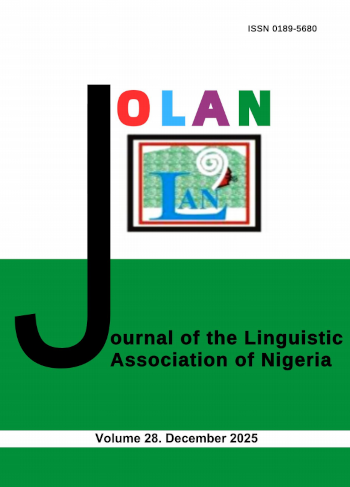Rescuing Endangered Cameroonian Languages through the Documentation and Publication of Digital Audio Materials
Keywords:
endangered language, documentation, publishing, Proclaimer, ScripturesAbstract
The majority of materials published in Cameroon are mainly on English and French even though most Cameroonians particularly those living in the rural areas speak local languages. In this era of globalization and multi-media platforms where information on sound and video gradually seems to be replacing books, this paper argues that the increased publication of materials in different audio formats and a strong government’s legislation for the introduction of all unwritten languages in education will greatly rescue endangered Cameroonian languages. The argument for publishing in endangered languages is proposed on the bases of some speakers’ increased involvement and participation in their communities’ literacy activities as a result of the ongoing use of the Proclaimer (audio Scriptures) in Mofu-Gudur, Bafut and Kako among others. Its use has not only enhanced and revalorized the statuses of these languages, but also shaped entrenched attitudes. This paper briefly presents the situation of endangered languages in Cameroon, and examines some challenges in publishing in indigenous languages. It also provides some reasons for publishing in these languages and the progressive publication of Scriptural materials in different gadgets and ends with some perspectives.
References
Achebe, C. 1975. The African writer and the English Language .Retrieved from: http:chisnell.com/APEng/BackgroundNotes/Achebe/tfasubaltern.rtf
Ansre, G. 1995. The Crucial Role of Oral Scriptures. Focus Africa. In International Journal of
Frontier Missions, Vol. 12:2 April – June.
Bamgbose, A. 1991.Language and the Nation. The Language Questions in Sub-Saharan Africa. Edinburgh: Edinburgh University Press.
Batibo, H. M. 2005. Language Decline and Death in Africa: Causes Consequences and Challenges. Clevedon: Multilingual Matters.
Chakava, H. 1996. Publishing in Africa: one man’s perspective. Nairobi: East Educational Publishers, Ltd.
Chiang, S. et al. (Eds.) 2004. Making Disciples of Oral Learners. Lausanne Occasional Paper (LOP) No. 54. Lima, NY: International Orality Network.
Chumbow, B. S. 2009. “Linguistic Diversity, Pluralism and National Development in Africa”. In CODESRIA. Africa Development, Vol. xxxix, No.2.2009. , pp.21-45.
Connell, B.1998.Moribund Languages of the Nigeria-Cameroon Borderland. Paper originally presented at the Symposium on Endangered Languages in Africa, Leipzig.
Crystal, D. 2000. Language Death. Cambridge: Cambridge University Press. Essien, 1983.The Orthography of the Ibibio Language, Calabar: Ibibio Language Panel.
Gordon. G. R. and F. B. Grimes Ethnologue: 2005Languages of the World. Fifteenth Edition. SIL International, Dallas, 7500 West Camp Wisdom Road, Dallas, Texas.www.sil.org.
Heugh, K. 2007.Language and literacy issues in South Africa. In N. Rassool. Global Issues in languages, education and development: perspectives from postcolonial languages. Clevedon: Multilingual Matters, pp.187–217.
Fierbaugh, S. 2013. Emerging ICT Trends Affecting Progressive Publication of Newly Translated Scripture. International Standard Book Number: XXX-X-XXX-XXXXX- X, United States. The Seed Company. Dallas: International Literacy and Development Inc. (ILAD) 2011
Gregorio, P. 2001. “African literature”. In B. Colinas& D. Person (eds).The Continuum Encyclopedia
of Children’s Literature. London: Continuum, pp. 13-15.
Koehler, P.F. 2010. Telling God’s story with power: Biblical storytelling in oral Cultures. Pasadena, CA: William Carey Library.
Krauss, M. 1992. The World’s language in crisis. Language 68: 4-10.
Kum'a Ndumbe III, P. 2007.Raising citizen awareness in the learning of African languages: Approach and experience of the Africavenir Foundation in Cameroon. In: Alexander, A. & Busch, B. (eds), Literacy and linguistic diversity in a global perspective: an intercultural exchange with African countries. Strasbourg Cedex: European Centre for Modern Languages, Council of Europe Publishing, pp. 39-48.
Krolak, Lisa, 2005.The role of libraries in the creation of literate environments. UNESCO Margetts,
Richard 2014. Which Audio Players? Listening to the translated Scriptures: A Review of today’s digital audio players. Third Edition - Revised for 2014.
Ngugi WaThiong'o, N. 1986. Decolonizing the Mind: The Politics of Language in African Literature. London: Heinemann
Ouane, Adama and Christine Glanz. 2011. Optimizing Learning, Education and Publishing in Africa: The Language Factor. UNESCO.
The Seed Company. 2013. VAST Translation Manual For the JESUS Film Script. Arlington: TSC. The Seed Company.2013. Progressive Publication- Seed Connect. https://wiki.seedconnect.org/ display/trantech/ProgressivePublication.
The Seed Company. 2013. SD Cards - Seed Connect. https://wiki.seedconnect.org/display/trantech/SD+Cards
SIL Annual literacy Report, 2011. SIL Cameroon, Yaounde.www.silcam.org
Skutnabb-Kangas, T. 2000.Linguistic genocide in education or world-wide diversity and Human rights? Mahwah, N.J.: Lawrence Erlbaum.
Swarr, D. & Koch, L. 2013. Media: The mortar that holds it together. Orality Journal 2(20), 87-93.
Tadadjeu, M. 2000. “Basic Standardization of all African Languages”. In, an Information bulletin for
literacy workers of the Cameroon branch, N° 9, July 2000.
Tasah, N..James 2012. “The Impact of Literacy in the Revitalization of Less Endangered Languages:
a Case Study of Bafut, Kom, Kako, and Ngiemboon” Unpublished PhD Thesis, University of
Yaounde1.
UNESCO 2003a.Education in a multilingual world. UNESCO Education Position Paper. Paris: UNESCO. Retrieved January 15, 2009 from: http://unesdoc.unesco.org/images/0012/001297/129728e.pdf
Wendy Davies 1997. “The Future of African Publishing”. In The Journal of the Dag Hammarskjöld
Foundation. pp. 1-29.














